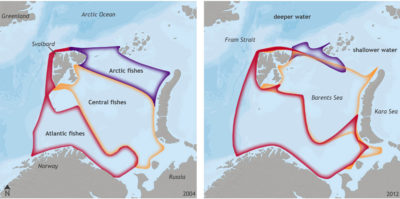As Arctic Warming Spikes, New Species, Warmer Currents From Atlantic & Pacific Head North
 In the Barents Sea, fish species typically found in the Atlantic Ocean, such as cod, beaked redfish, and long rough dab, have moved north and displaced Arctic fishes. NOAA Climate.gov
In the Barents Sea, fish species typically found in the Atlantic Ocean, such as cod, beaked redfish, and long rough dab, have moved north and displaced Arctic fishes. NOAA Climate.gov
EDIT
On the Pacific side, humpback whales, a sub-Arctic species, have been observed in recent years as far north as Utqiaġvik (formerly called Barrow), off Alaska’s North Slope, where they had not been reported before. Moore thinks the whales are feasting on pulses of Pacific krill and other food streaming into the Arctic. Reduction in sea ice also allows whales to arrive earlier and stay later, giving them more time to feed and reproduce.
And this past winter, when sea ice in the Alaskan Arctic formed up to three months late and disappeared at the earliest date on record, “We had bowhead whales in the Chukchi Sea pretty much overwinter —we have never seen that before now,” says Moore, who is co-leader of the Synthesis of Arctic Research project, an international collaboration of polar experts looking at the effects of a changing Pacific Arctic on marine life.
Along the Arctic coast of western Canada, indigenous fishermen report salmon venturing unusually far north, says Carolina Behe, the indigenous knowledge science advisor for the Inuit Circumpolar Council-Alaska. And scientists conducting an Arctic ecosystem survey in 2008 were surprised to find walleye pollock and Pacific cod in the Beaufort Sea, said Elizabeth Logerwell, an ecologist with the NOAA Alaska Fisheries Science Center who worked on the survey. If these more southern species extend their range north, they could potentially supplant native Arctic fish. She cautioned, however, that the region lacks long-term historical fish survey data, making it hard to know for certain whether these were actually new arrivals or just being scientifically observed for the first time.
Scientists do say that the intrusion of Pacific waters is taking a toll on seabirds in the Alaskan Arctic. Traditional summer denizens in the Chukchi Sea — such as black-legged kittiwakes, thick-billed murres, and glaucous gulls — are now being supplanted by least and crested auklets, northern fulmars, and short-tailed shearwaters, which had not previously ventured so far north. The shift reflects a change in the birds’ prey, with new prey species being swept north through the Bering Strait. The change is causing an overall decline in seabird numbers, a recent paper concludes.
EDIT
https://e360.yale.edu/features/alien-waters-neighboring-seas-are-flowing-into-a-warming-arctic-ocean
